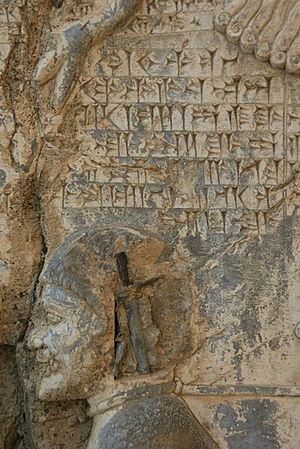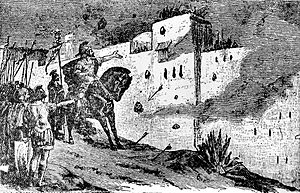Nebuchadnezzar III facts for kids
Quick facts for kids Nebuchadnezzar III |
|
|---|---|

Nebuchadnezzar III and associated inscription in Darius I's Behistun Inscription
|
|
| King of Babylon | |
| Reign | September/October – December 522 BC |
| Coronation | 3 October 522 BC (?) |
| Predecessor | Bardiya (Achaemenid Empire) |
| Successor | Darius I (Achaemenid Empire) |
| Died | December 522 BC Babylon |
| Akkadian | Nabû-kudurri-uṣur |
| House | Zazakku |
| Dynasty | Chaldean dynasty (claimed) |
| Father | Mukīn-zēri or Kîn-Zêr (actual) Nabonidus (claimed) |
Nebuchadnezzar III (Babylonian cuneiform: ![]() Nabû-kudurri-uṣur, meaning "Nabu, watch over my heir") was a rebel king of Babylon in late 522 BC. His original name was Nidintu-Bêl. He tried to make Babylonia an independent kingdom again. He wanted to end the rule of the Persian Empire in Mesopotamia.
Nabû-kudurri-uṣur, meaning "Nabu, watch over my heir") was a rebel king of Babylon in late 522 BC. His original name was Nidintu-Bêl. He tried to make Babylonia an independent kingdom again. He wanted to end the rule of the Persian Empire in Mesopotamia.
Nidintu-Bêl was a Babylonian noble from the Zazakku family. His father was named Mukīn-zēri or Kîn-Zêr. When he became king, Nidintu-Bêl took the royal name Nebuchadnezzar. He also claimed to be the son of Nabonidus, who was Babylon's last independent king.
The first mention of Nebuchadnezzar III as king is from October 3, 522 BC. This might have been the day he became king. His revolt probably started because people didn't like the Persian king Bardiya. However, Bardiya had already been overthrown by Darius I when the revolt began.
Nebuchadnezzar III quickly took control of Babylonia. He ruled not only Babylon but also the cities of Borsippa, Sippar, and Uruk. He might have controlled all of Babylonia. On December 13, Nebuchadnezzar III and his army could not stop the Persians from crossing the Tigris river. Five days later, on December 18, he was badly defeated in a battle near Zazana by the Euphrates river. After this loss, Nebuchadnezzar III ran to Babylon. Darius quickly captured Babylon, and Nebuchadnezzar III was executed.
Why Did Babylonia Revolt?
The Neo-Babylonian Empire was the last great empire in Mesopotamia ruled by local kings. This important time in Babylonian history ended when the Persian Empire conquered Babylon in 539 BC. This happened under Cyrus the Great. After this, Babylon never became the capital of an independent kingdom again.
However, Babylon was still an important city. It had a large population, strong walls, and active religious practices. The city even became one of the Persian Empire's capitals, along with Pasargadae, Ecbatana, and Susa. This meant it was still important and not just a small provincial city. But the Persian rulers were not from Babylonia. They had other main cities outside Mesopotamia. Because of this, Babylon's special status was not as strong as before.
The Persian kings still used the title King of Babylon and King of the Lands. But over time, the Babylonians became less happy with Persian rule. It wasn't just because the Persians were foreigners. Many foreign rulers had been supported by Babylonians in the past. What mattered more was whether a king followed Babylonian traditions.
The Persian kings had capitals in other parts of their empire. They rarely took part in Babylon's traditional religious events. These events often needed the king to be there. They also rarely built temples or gave gifts to the city's gods. Because of this, Babylonians might have felt that the Persian kings were not doing their royal duties. They might have thought the kings did not have divine support to be true kings of Babylon.
The Revolt Against Persia
Babylon revolted against Persian rule several times. The first revolt was led by Nebuchadnezzar III in 522 BC. This was 17 years after the Persians took over the city. The revolts in Babylon usually got the most support from families connected to the city's priests.
Nebuchadnezzar III's original name was Nidintu-Bêl. He came from a local family called Zazakku. His father's name was Mukīn-zēri or Kîn-Zêr. When he rebelled against the Persians, Nidintu-Bêl took the name Nebuchadnezzar. He also said he was the son of Nabonidus, Babylon's last independent king.
At the time of the revolt, the Achaemenid Empire was in chaos. Many parts of the empire were rebelling against the new king, Darius I. It's likely that many of these revolts were originally planned against Darius I's predecessor, Bardiya. Bardiya had been overthrown by Darius.
The earliest record of Nebuchadnezzar III's rule is a clay tablet from October 3, 522 BC. This tablet mentions it was written in his first year as king. This might have been the day he became king. Nebuchadnezzar might have been an older man when he took the throne. He is shown as an old man with a short beard in Darius's Behistun Inscription. This inscription tells the story of how Nebuchadnezzar and other rebels were defeated.

Nebuchadnezzar wanted to make Babylonia an independent country. His revolt was probably first aimed at getting rid of the unpopular Bardiya. Darius's inscriptions say that Nebuchadnezzar revolted after Bardiya's death. However, his revolt could not have started later than October 3. This was only four days after Bardiya was killed in Media, which was hundreds of kilometers from Babylon.
The tablet from October 3 was written in Sippar, 60 kilometers north of Babylon. It seems unlikely that Nebuchadnezzar could have started a revolt, captured Sippar, and been recognized as king there within four days. The last Babylonian document that mentions Bardiya as king is from September 20. This suggests that the Babylonians had been planning their uprising for some time. The ancient Greek writer Herodotus said they had been preparing throughout Bardiya's short reign.
Darius quickly moved against Nebuchadnezzar. But Nebuchadnezzar ruled without interruption for a few months. This was true in Babylon itself and in the cities of Borsippa, Sippar, and Uruk. It's possible that Nebuchadnezzar's rule was accepted throughout all of Babylonia.
In early December, Darius's army was close to the Tigris river. They planned to cross it to enter Babylonia. To stop the Persians, Nebuchadnezzar placed his troops in the river's reed thickets. He hoped to guard the crossing and capture Darius's boats. On December 13, the Persians outsmarted the rebels. They crossed the river on inflated animal skins and defeated the Babylonian forces.
On December 18, the Babylonians suffered a major defeat in a second battle. This battle happened near Zazana by the Euphrates river. After this second loss, Nebuchadnezzar fled back to Babylon with his remaining cavalry. Darius then quickly captured Babylon. Nebuchadnezzar was caught and executed. The earliest known Babylonian tablet that recognizes Darius as king of Babylon is dated December 22.
Nebuchadnezzar's Legacy
Less than a year after Nebuchadnezzar III's defeat, another noble continued the Babylonian resistance. This was Arakha, from the Urartian (Armenian) region. He was the son of a man named Haldita. Arakha played down his Urartian background. He declared himself Babylon's king under the name Nebuchadnezzar IV.
By taking the same name as his predecessor, Nebuchadnezzar IV wanted his own rebellion to seem like a continuation of Nebuchadnezzar III's. He tried to get support from Babylon's religious leaders. He brought statues of gods from the cities of Uruk and Larsa to Babylon for protection. He also dated his documents to his first year as king, not his accession year. This showed that his revolt was a direct continuation of Nebuchadnezzar III's uprising.
Nearly 200 years after Nebuchadnezzar III's defeat, in 336/335 BC, another Babylonian rebel appeared. This was Nidin-Bel. He might have chosen his royal name as a tribute to Nebuchadnezzar III, whose original name was Nidintu-Bêl.
See also
 In Spanish: Nabucodonosor III para niños
In Spanish: Nabucodonosor III para niños


